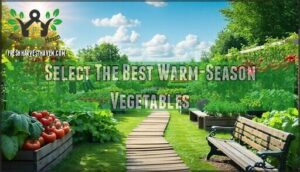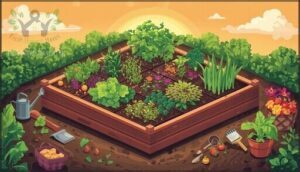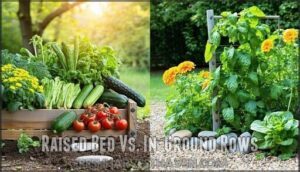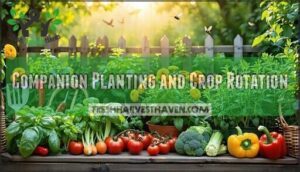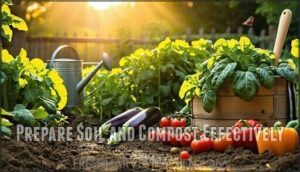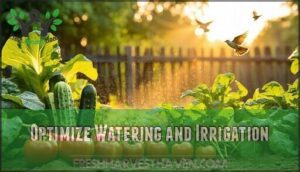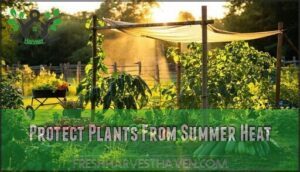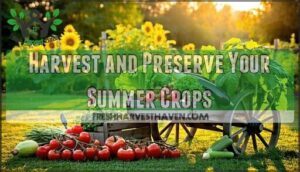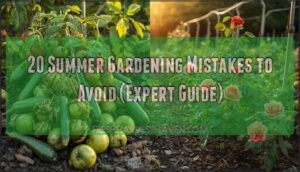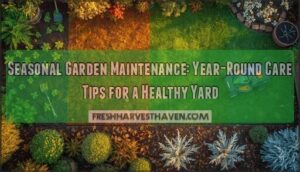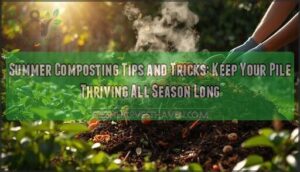This site is supported by our readers. We may earn a commission, at no cost to you, if you purchase through links.
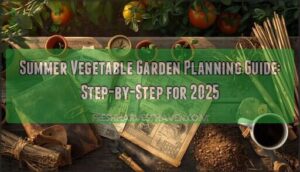
The difference between a struggling patch of wilted plants and a garden that floods your kitchen with peppers, melons, and okra comes down to the prep work you do now. Smart planning means understanding your space, choosing the right heat-loving varieties, and building soil that can cope with the brutal demands of summer heat—so your plants thrive instead of just survive.
Table Of Contents
- Key Takeaways
- Assess Your Summer Garden Space
- Select The Best Warm-Season Vegetables
- Plan Your Garden Layout for Success
- Prepare Soil and Compost Effectively
- Optimize Watering and Irrigation
- Protect Plants From Summer Heat
- Harvest and Preserve Your Summer Crops
- Frequently Asked Questions (FAQs)
- What is the most common mistake of first time gardeners?
- What is vegetable gardening?
- Can you grow vegetables in a suburban backyard?
- How do you plan a vegetable garden?
- How do I choose a vegetable garden?
- How do I Manage my vegetable garden?
- When is the best time to start a vegetable garden?
- What is a good layout for a vegetable garden?
- When to start planting summer vegetables?
- What vegetables should not be planted next to each other?
- Conclusion
Key Takeaways
- Your summer garden’s success hinges on prep work done months in advance—soil testing, crop rotation mapping, and succession planting schedules matter more than last-minute planting decisions.
- Vertical gardening and square-foot layouts can triple your yield in tight spaces by stacking crops on trellises and maximizing every square foot with strategic plant spacing.
- Deep watering builds drought-tolerant roots while drip irrigation cuts water use by 66%—morning watering between 5–10 a.m. minimizes evaporation and heat stress.
- Heat protection through 30–50% shade cloth, 2–4 inches of mulch, and proper plant spacing drops root zone temperatures by 10°F and prevents blossom drop during peak summer.
Assess Your Summer Garden Space
Before you break ground on your summer garden, you need to know what you’re working with. Taking stock of your available space, light conditions, and soil quality will save you from planting the wrong crops in the wrong spots.
Let’s walk through how to assess your garden space so you can make smart decisions about what to grow and where to put it.
Evaluating Sunlight and Soil Conditions
Before you even think about planting a single seed, you need to get up close and personal with your garden’s sunlight patterns and soil quality—these
- Measure soil temperature (aim for 60°F minimum)
- Assess soil moisture levels and drainage
- Conduct soil testing for pH and nutrients
- Evaluate garden soil texture and structure
- Note areas needing soil preparation amendments
Measuring and Sketching Garden Beds
Once you know where the sun hits and what your soil needs, grab a tape measure and some graph paper—mapping out your beds with real dimensions keeps you from overplanting or wasting prime real estate.
Use graph paper planning to create an accurate spatial layout, marking each garden bed design with measurements and noting soil preparation zones. This yard measurement process turns vague garden space into a concrete garden layout—you’ll spot gaps, avoid crowding, and see exactly where soil mapping reveals opportunities for smarter garden design.
Finding New Space for Summer Planting
Summer planting doesn’t stop just because your spring beds are full—you can pull spent crops like arugula and cilantro the moment they bolt, then drop warm-season transplants into the same spot before the soil even cools.
Garden expansion happens in overlooked corners, too—scan your yard for underused zones where container gardening or small space solutions fit:
- Driveway edges with six hours of sun for potted peppers
- Side yards too narrow for walkways but perfect for vertical gardens
- Patio corners that hold grow bags of squash
- Front walkways lined with compact tomato containers
- Fence lines ready for trellised beans in summer garden setups
Maximizing Small Spaces With Vertical Gardening
Vertical gardening turns fence lines, walls, and trellises into productive real estate when you’re tight on ground space—pole beans can climb eight feet and yield pounds of pods from a single square foot of soil. Trellis systems guide indeterminate varieties upward instead of outward.
Vertical planters mounted on garden walls let you stack cucumbers and tomatoes above sprawling squash. Container gardening pairs perfectly with compact setups—hang pots along fence rails or use tiered vertical gardening racks to triple your summer vegetable garden output without expanding your footprint.
Select The Best Warm-Season Vegetables
Picking the right vegetables is where your summer garden starts to take shape. You’ll want plants that can tolerate the heat and keep producing well into the season.
Let’s break down the best options for warm-season growing, from classic favorites to heat-loving superstars that thrive when temperatures climb.
Beans, Squash, and Tomatoes for Summer
These three workhorses—beans, squash, and tomatoes—form the backbone of almost every productive summer garden, delivering reliable harvests even when you’re still figuring out your green thumb. Smart seed selection and soil preparation set you up for success:
- Pole beans climb fast, turning vertical space into vegetable gardening gold
- Summer squash produces so abundantly you’ll be sharing with neighbors
- Indeterminate tomatoes keep fruiting all season long
- Crop rotation prevents pest management headaches down the line
Mix these with thoughtful garden layout and you’ve got harvesting summer vegetables covered.
Heat-Tolerant Crops: Okra, Peppers, and Melons
When the thermometer refuses to drop below 90°F and your garden feels more like a sauna than a sanctuary, okra, peppers, and melons are the heat-loving heroes that actually thrive in conditions that make other crops throw in the towel.
Okra varieties like ‘Clemson Spineless’ laugh at heat stress, producing pods daily once established.
Peppers need consistent pepper care—deep watering and crop rotation—to sidestep melon diseases and boost your summer garden’s heat tolerance potential.
Choosing Varieties for Your Region
Your climate zone dictates victory or defeat in the summer vegetable garden. Regional adaptation drives 60% to 80% of yield variation—broccoli thriving in the Midwest often struggles in southeastern heat, while southern pepper varieties outproduce generic options by up to 26%.
Choose disease-resistant cucumbers for humid zones and drought-tolerant tomatoes for arid regions. Consult your extension service’s variety trials; growers using these recommendations see $550 to $850 more revenue per acre through smart variety selection matched to local heat tolerance and disease resistance needs.
Understanding the best regional veggie options is essential for a successful harvest.
Succession Planting for Continuous Harvest
Stagger your plantings every 10 to 14 days, and you’ll dodge the feast-or-famine cycle that leaves gardeners drowning in zucchini one week and empty-handed the next. Succession planting transforms your beds into a production line—seed staggering keeps harvest scheduling predictable while crop rotation prevents soil depletion.
- Plant fast-maturing beans every two weeks through mid-July for continuous pods
- Rotate lettuce into freed tomato space after spring crops finish
- Track growth cycles to anticipate replanting windows
- Adjust plant spacing for airflow as summer heat intensifies
- Schedule final sowings 8-10 weeks before first frost
Plan Your Garden Layout for Success
A smart layout turns good intentions into great harvests. The way you arrange your beds, paths, and plants determines how much you can grow and how easily you can maintain it all.
Here’s how to design a summer garden that works with you, not against you.
Square-Foot Gardening Techniques
If you’re working with limited space or just want to squeeze more production out of every square foot, this method turns your garden beds into a high-yield grid system that practically plans itself. You divide your bed into 1×1-foot squares, then plant each square according to spacing needs—one tomato, four beans, or sixteen radishes per square. This intensive planting maximizes your summer garden while keeping vertical layers and soil blocks organized.
| Plant Type | Plants Per Square | Examples |
|---|---|---|
| Large (12" spacing) | 1 | Tomatoes, peppers, eggplant |
| Medium (6" spacing) | 4 | Beans, chard, okra |
| Small (3" spacing) | 9-16 | Radishes, carrots, beets |
| Vertical climbers | 2-4 | Pole beans, cucumbers, melons |
Grid planning transforms space optimization into a visual game—you can see exactly what fits where, making gardening techniques accessible even for beginners tackling small space gardening ideas.
Raised Bed Vs. In-Ground Rows
The choice between raised beds and in-ground rows isn’t just about aesthetics—it’s about matching your growing method to your soil reality and the kind of garden maintenance you’re actually willing to do.
Raised beds give you control over garden soil quality and drainage systems from day one, especially if you’re dealing with heavy clay or contaminated ground. You can choose bed frame options from cedar to galvanized steel, customize soil depth for root crops, and improve garden accessibility.
In-ground rows work beautifully if your native soil drains well and you’ve got room to spread out your summer garden without wrestling with raised bed materials.
Companion Planting and Crop Rotation
Once you’ve settled your bed structure, smart companion planting and crop rotation become your secret weapons for soil enrichment and natural pest control. Pairing marigolds with tomatoes can slash pest issues by up to 60%, while rotating heavy feeders like corn with nitrogen-fixing beans keeps your soil rich and balanced.
Here’s how to leverage crop diversity for ecosystem balance:
- Plant basil near peppers to deter aphids and boost pollinator support with fragrant blooms
- Rotate tomato families annually to prevent soil-borne diseases and maintain nutrient levels
- Interplant squash as groundcover to suppress weeds and keep soil cool during peak heat
- Add flowering companions like borage to increase bee visits by 42% and improve fruit set across your entire summer garden
Succession planting works hand-in-hand with rotation—as early crops finish, immediately replace them with complementary species that benefit from the enriched soil left behind. Understanding soil health benefits is essential for maximizing crop yields and maintaining a balanced ecosystem.
Incorporating Trellises and Shade Cloth
Vertical trellises and strategic shade cloth don’t just save space—they turn summer’s biggest challenges into your advantages. Train pole beans and cucumbers up sturdy trellis designs for vertical support, freeing ground real estate for heat-loving peppers.
Drape 30-50% shade cloth as garden screens and sun filters over delicate greens during peak afternoons—you’ll cut heat stress while boosting yields across your entire summer garden layout.
Prepare Soil and Compost Effectively
Your summer crops will only be as good as the soil that feeds them. Before you plant a single seed, you’ll need to get your beds prepped with the right amendments, organic matter, and protective layers.
Let’s break down how to build a thriving foundation for heat-loving vegetables.
Amending Soil for Summer Crops
Summer crops strip nutrients fast, so you’ll want to get ahead with proper soil management. Start with soil testing to check pH levels—most vegetables prefer 6.0 to 7.0. Add organic amendments like aged compost to boost nutrient cycling and microbial activity.
These summer gardening tips guarantee your beds feed plants all season, not just at planting time.
Composting Tips for Nutrient-Rich Beds
Once you’ve fed your soil the right amendments, building your own compost pile takes that nutrient game to the next level—and it’s easier than you think. Mix nitrogen-rich greens with carbon-heavy browns to fuel soil microbes that drive nutrient cycling.
Turn your pile weekly to speed decomposition and reduce waste. In a few months, you’ll have dark, crumbly organic matter that acts like gold for soil management—pure organic fertilizer your plants will devour.
Mulching to Retain Moisture and Suppress Weeds
Spread a thick layer of organic mulch around your plants, and you’ll slash watering chores while choking out weeds before they even think about sprouting. Straw, shredded leaves, or wood chips work as a natural weed barrier while regulating soil temperature and locking in moisture.
- Apply 2-4 inches of mulch materials around plant bases, keeping it away from stems to prevent rot
- Refresh your mulch mid-season to maintain water conservation and cooling benefits
- Dark mulch absorbs heat—switch to lighter materials in extreme climates for better soil temperature control
Optimize Watering and Irrigation
Getting water right is what separates thriving summer gardens from struggling ones. You’ll need a strategy that keeps roots deep, plants cool, and your water bill reasonable.
Here’s how to set up an irrigation system that works smarter, not harder.
Deep Watering to Strengthen Roots
If you want roots that dive deep instead of lounging near the surface, watering technique matters more than you might think. Soak your soil thoroughly but less often—this pushes roots down for better water absorption and drought tolerance. Morning irrigation timing reduces evaporation and strengthens root growth.
| Watering Method | Root Depth Impact |
|---|---|
| Frequent shallow watering | Roots stay near surface, vulnerable to heat |
| Deep watering (6-8 inches) | Roots reach deeper soil moisture layers |
| Consistent deep watering | Builds drought tolerance and nutrient access |
Setting Up Drip Irrigation Systems
Drip irrigation delivers water right where your plants need it—straight to the root zone—without wasting a drop on pathways or foliage.
Set up your drip system design by laying soaker hoses or emitter lines along rows, adjusting pipe sizing for your garden’s length.
Add irrigation controllers to automate watering based on soil moisture levels, giving you water efficiency without the daily hassle—pure liberation for busy gardeners.
Best Times to Water in Hot Weather
Water your summer vegetables in the early morning hours—ideally between 5 and 10 a.m.—when temperatures are coolest and evaporation rates hit rock bottom. This morning hydration strategy maximizes soil moisture retention and gives plants time to absorb what they need before heat stress kicks in.
Here’s your timing playbook:
- Morning Hydration (5–10 a.m.): Prime time for drip irrigation—plants drink deep, foliage dries fast, disease pressure drops.
- Late Evening (after 6 p.m.): Second-best option if mornings don’t work, though leaves stay wet longer.
- Midday Watering: Avoid it—evaporation steals half your water before roots get fed.
- Soil Moisture Check: Stick your finger 2 inches down; if it’s dry, water regardless of time.
Conserving Water in Drought-Prone Areas
Smart irrigation and water management separate thriving summer gardens from struggling ones in drought-prone zones. Install drip irrigation paired with soil moisture sensors—this combo can slash water use by up to 66% while targeting root zones with 95% efficiency. Layer 3–4 inches of mulch to lock in soil moisture, and consider greywater use from laundry or sinks to sustain daily watering.
Smart controllers programmed for early morning runs minimize evaporation by 30%, and shade cloth over heat-sensitive crops reduces transpiration stress while stretching every drop further.
Protect Plants From Summer Heat
When temperatures soar past 85°F, your summer garden can go from thriving to struggling in a matter of days. The good news is that you don’t have to watch your plants wilt—there are proven strategies to keep them cool, hydrated, and productive even during the hottest weeks.
Here’s how to shield your vegetables from scorching sun and heat stress.
Using Shade Cloth for Sensitive Vegetables
When summer heat cranks up past 90°F, even your toughest tomatoes and peppers can start waving the white flag—that’s where shade cloth becomes your secret weapon.
Drape 30-50% shade cloth over hoops or frames during peak afternoon hours to block intense rays while maintaining airflow.
This simple summer sun protection prevents blossom drop and sunscald, keeping your vegetable garden thriving when temperatures soar.
Mulching and Plant Spacing for Cooling
Beyond shade cloth, your soil surface holds another cooling trick—layer on 2-3 inches of organic mulch and give each plant room to breathe, and you’ll drop root zone temperatures by up to 10°F. Straw, shredded leaves, or wood chips work as excellent mulch materials, locking moisture in while keeping soil temperature steady.
Space plants wider than usual—reducing plant density improves airflow and prevents heat buildup. These cooling techniques transform your summer garden into a resilient, productive powerhouse without breaking the bank.
Monitoring and Preventing Heat Stress
Even with perfect mulch and spacing, your plants will send distress signals if the mercury climbs too high—and catching those signs early means the difference between a thriving crop and a scorched failure. Watch for wilted leaves in morning hours, leaf curl, or blossom drop—classic heat stress symptoms.
Check soil temperature daily; anything above 85°F demands immediate shade strategies or water conservation adjustments. Your summer garden thrives when you spot trouble before it tanks your heat tolerance completely.
Managing Pests and Diseases in Hot Weather
Heat stress weakens your plants’ defenses, and hot weather breeds pests like aphids and spider mites that can explode by 30–50% during heat waves.
You’ll want integrated strategies: release beneficial insects like lacewings for biological management, mulch heavily to prevent soil-borne pathogens, and prune for airflow to cut disease resistance issues.
Remove infected leaves immediately—this simple pest and disease management step slashes spread by up to 70% in your summer garden.
Harvest and Preserve Your Summer Crops
You’ve put in the work—now it’s time to reap the rewards of your summer garden. Knowing when and how to harvest keeps your plants producing all season long, and proper storage means you’ll enjoy fresh flavors well beyond summer.
Let’s walk through the essentials of timing your harvest, managing each crop with care, and making your bounty last.
Recognizing Ripeness for Common Vegetables
Knowing exactly when to pick your vegetables can mean the difference between a mediocre meal and one that makes you feel like a garden rockstar. Here’s how recognizing vegetable ripeness works for your summer harvest:
- Tomatoes: Fruit color shifts from green to deep red (or variety-specific hue); they’ll feel slightly soft when gently squeezed
- Beans: Pods snap crisply when bent; seeds inside remain small and tender at peak maturity stages
- Watermelons: The ground spot turns creamy yellow; nearby tendrils brown and dry
- Squash: Vegetable texture feels firm; harvest timing matters—pick zucchini at 6-8 inches for best flavor
Proper Harvesting Techniques for Each Crop
Harvesting the right way—not just at the right time—keeps your vegetables in prime condition and your plants producing longer. Use sharp, clean pruners or scissors to avoid damaging stems during harvest timing.
For tomatoes, twist gently at the stem joint; for beans, support the plant while pulling pods.
Always manage fruit selection with care—bruising accelerates spoilage and affects post-harvest care quality for your summer vegetables.
Storing and Preserving Summer Vegetables
Once your vegetables hit their harvest peak, knowing how to store and preserve them properly means you’re not stuck eating thirty zucchinis in one week or watching that tomato haul turn to mush.
Freezing methods work great for preserving beans, while canning techniques and pickling recipes transform tomatoes and cucumbers into shelf-stable gold.
Dehydrating foods concentrates flavors, and storing melons in cool spots extends their life—harvesting and preserving is where your garden freedom truly pays off.
Extending The Harvest With Succession Planting
If you stagger your plantings every two to three weeks, you’ll keep fresh vegetables rolling in until the first frost—no more feast-or-famine harvests. Succession planting and smart harvest scheduling let you practice garden renewal all season long.
Plant beans after spring greens, rotate tomatoes into freed-up beds, and watch your summer gardening tips turn into continuous yields with proper seasonal planning and crop rotation.
Frequently Asked Questions (FAQs)
What is the most common mistake of first time gardeners?
First-time gardeners often bite off more than they can chew—planting too much, too close together. Overcrowding plants leads to poor air circulation, disease, and stunted growth.
Start small, focus on proper spacing, and do your research before you dig in.
What is vegetable gardening?
Vegetable gardening means growing edible plants—like tomatoes, peppers, beans, and squash—in your own space.
You’ll prep soil, choose crop management strategies, and follow gardening basics to harvest fresh food all season long.
Can you grow vegetables in a suburban backyard?
You can absolutely grow vegetables in a suburban backyard—size doesn’t limit your success. With smart garden planning and design tips like vertical trellises and succession planting, even small space gardening produces impressive yields.
Suburban garden tips and backyard farming techniques turn any plot into productive urban agriculture.
How do you plan a vegetable garden?
Start by sketching your garden beds on graph paper to visualize space, then assess sunlight, test soil conditions, and list crop priorities using succession planting for continuous harvest throughout the season.
How do I choose a vegetable garden?
Your garden size, soil type, and climate zone aren’t just details—they’re the blueprint for plant diversity and space efficiency. Understanding these factors means you’ll choose vegetables that actually thrive instead of just survive, maximizing every square foot you’ve got for summer planting success.
How do I Manage my vegetable garden?
Managing your vegetable garden successfully means staying on top of Soil Testing, Crop Monitoring, and Pest Control while keeping up with Watering and Irrigation, Fertilizer Management, and Garden Maintenance and Care.
Additionally, tracking everything in a Garden Record can help improve your Gardening Tips and Harvesting Techniques for next season.
When is the best time to start a vegetable garden?
Timing is everything—miss your frost dates and you’re replanting from scratch.
Start your vegetable garden two weeks after your last spring frost date, when soil temperatures reach at least 50°F for most crops, using your USDA climate zone and gardening calendar to guide seed starting and garden planning.
What is a good layout for a vegetable garden?
Try square-foot gardening for space optimization—it’s the supreme rebellion against chaotic rows.
Map your edible garden with grouped plants based on height and sunlight needs, add pathways for easy maintenance, and watch your vegetable garden layout transform into a high-yielding masterpiece.
When to start planting summer vegetables?
Who doesn’t love guessing games when food is on the line? You’ll want to plant warm season vegetables after your last frost date when soil temperature hits 60°F.
Check your climate zones and plant hardiness for precise timing—succession planting through summer keeps your vegetable garden producing continuously.
What vegetables should not be planted next to each other?
Keep beans away from onions and garlic, which stunt their growth. Don’t pair tomatoes with brassicas or fennel with most vegetables—crop interference disrupts plant compatibility.
Smart companion planting and garden layout prevent these vegetable pairs from competing.
Conclusion
Most gardeners overthink the harvest and ignore the foundation—but your summer vegetable garden planning guide success lives in the soil prep, layout decisions, and watering strategy you lock in before June heat arrives.
Skip the guesswork: test your soil, map your beds with companion planting in mind, and install drip lines now so your tomatoes, peppers, and melons don’t just survive—they dominate.
Plan like you mean it, and your garden will reward you with baskets of produce all season long.
- https://www.almanac.com/vegetable-gardening-for-beginners
- https://growit.wiki/vegetable-planting-guide/
- https://www.gardeningknowhow.com/edible/planning-a-vegetable-garden-15-expert-tips
- https://thegardening.org/blog/best-vegetables-to-grow-in-summer/
- https://blog.dutch-bulbs.com/seasonal-gardening-tips-for-keeping-your-garden-thriving-in-summer/

